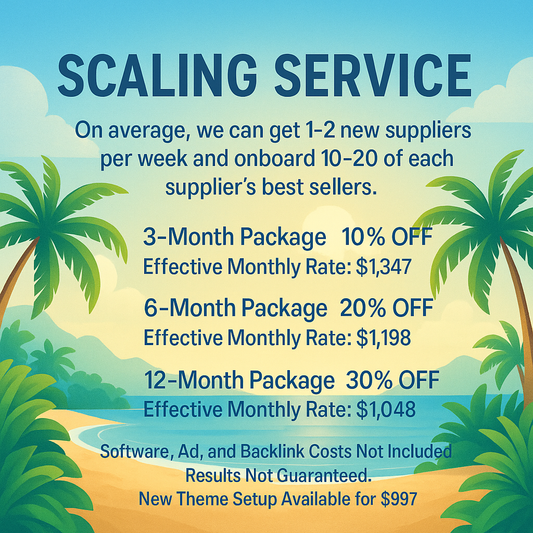
Boosting High Ticket Sales with Data Analytics
Hello, future eCommerce moguls! Trevor Fenner here from Ecommerce Paradise, and today we’re diving deep into the compelling world of data analytics. In the fast-paced environment of online retail, especially when running a high-ticket dropshipping store, harnessing the power of data can be the game changer that elevates your business. Are you ready to unlock your store's potential? Let’s get started!
Understanding Data Analytics: The Backbone of Your Business
Before we delve into how data analytics can directly impact your high-ticket sales, let's take a moment to understand what data analytics is. In essence, it’s the practice of collecting and examining data to uncover insights, trends, and patterns. In our case, we will look at metrics relevant to your dropshipping high ticket business.
Why is this important? Well, without understanding your data, you’re navigating your business in the dark. But once you shed light on your operations, you can make informed decisions that drive profitability, boost customer satisfaction, and increase sales.
Setting Your Data Analytics Goals
Before you start collecting data, it’s crucial to outline your goals. What do you want to achieve with your high-ticket dropshipping store? Here are some goals that can guide your analytics journey:
- Identify customer purchasing patterns
- Gauge the effectiveness of marketing campaigns
- Optimize inventory management
- Enhance customer service and support
- Increase conversion rates
Setting clear goals will enable you to focus on the right data points that drive your sales and growth. Remember, it’s not about collecting data for the sake of it; it’s about collecting actionable insights that lead to tangible results!
Key Metrics to Track for High-Ticket Sales
Now that we’ve established our goals, let’s discuss the critical metrics every dropshipping high ticket business should track:
1. Customer Acquisition Cost (CAC)
The first step to scaling your high-ticket sales is understanding how much it costs to acquire a customer. By analyzing your customer acquisition cost, you can figure out which marketing channels are yielding a positive return on investment. This insight will empower you to allocate your budget more effectively.
2. Average Order Value (AOV)
For high-ticket items, the Average Order Value is crucial. Higher AOV means more revenue per sale, which is essential when your profit margins are slim. Analyze the data to see which items customers typically purchase together and consider bundling those products. This tactic can help increase your AOV and boost your overall sales!
3. Conversion Rate
Your conversion rate reflects how many visitors are making purchases compared to the total number of visitors to your store. By analyzing this metric, you can identify areas for improvement. Are your product descriptions compelling enough? Is your site user-friendly? These insights can lead to improvements that drive more high-ticket sales.
4. Return on Ad Spend (ROAS)
Return on Ad Spend is vital for any eCommerce business, especially for a high-ticket dropshipping store. Understanding which ads perform best can guide your marketing strategy. If certain campaigns yield a better ROAS, you can allocate more resources towards those efforts and potentially maximize your profits!
5. Customer Lifetime Value (CLV)
Customer Lifetime Value helps you understand the total worth of a customer over time. Knowing this metric allows you to calculate how much you should invest in acquiring customers while remaining profitable. The greater your CLV, the more you can spend on marketing while still being in the green!
Leveraging Data to Make Informed Decisions
After identifying and tracking critical metrics, it's time to put your data to good use. Here’s how to leverage your analytics for maximum impact:
Make Data-Driven Marketing Decisions
Your marketing strategy should be guided by data. Analyze what channels are driving the most high-ticket sales and invest in those. A/B testing different ad creatives, email marketing campaigns, and even social media promotions can help you understand what resonates best with your audience.

Personalize Customer Experience
Data analytics can help you create a personalized shopping experience. By understanding your customers' behavior and preferences, you can tailor product recommendations and marketing messages that resonate with them. A personalized approach can significantly enhance customer satisfaction and lead to repeat sales—especially in high-ticket items!
Inventory Management and Forecasting
Proper inventory controls are essential for a high-ticket dropshipping store. Data analytics can help you forecast demand based on historical sales data—minimizing excess inventory and reducing stockouts. Knowing what products are trending will ensure you have the right items in stock at the right time, enabling you to seize those high-ticket sales!
Enhancing Customer Service
Using data analytics, you can analyze customer interactions and feedback. This can provide insights into what your customers are saying about their shopping experience and what improvements they suggest. Implementing the necessary changes based on this data can enhance customer satisfaction, creating loyal customers who make regular high-ticket purchases.
The Role of Software Tools in Data Analytics
To effectively analyze data and extract insights, leveraging software tools is essential. Here are some recommended tools that can help you streamline your analytics:
- Google Analytics: A must-have for tracking website traffic, user behavior, and conversion rates.
- Hotjar: Provides heatmaps to help you understand where customers click and interact most.
- Shopify Analytics: If you have a high-ticket dropshipping store on Shopify, their built-in analytics tools are invaluable for tracking sales performance, customer data, and trends.
- Klaviyo: Great for email marketing analytics; helps improve open rates and conversions.
Using these tools will allow you to automate data collection, visualize metrics, and generate reports easily—so you can spend more time focusing on your business growth!
Training Your Team to Utilize Data
Having the right tools is one thing, but ensuring your team knows how to use them is where the magic really happens! Invest time in training your staff on data analytics best practices. The more they understand about interpreting data and making informed decisions, the more your high-ticket dropshipping store will thrive.
Transforming Insights Into Action
Now that you’ve got your metrics and tools in place, it’s time to implement actionable strategies based on your data-driven insights!
- Develop targeted marketing campaigns based on customer preferences.
- Optimize website navigation based on user behavior analytics.
- Offer personalized promotions to loyal customers based on their purchase history.
- Regularly review and adjust your strategy based on changing trends and metrics.
Your goal is to evolve and adapt constantly. In the fast-paced world of eCommerce, standing still means falling behind.
Success Stories: Real-World Examples
Nothing drives home the importance of data analytics like real-world examples. Many successful eCommerce businesses have harnessed the power of data to significantly boost their revenue. Here’s a short overview of how others have done it:
- The Home Depot: Used data analytics to optimize their in-store and online inventory, leading to significant sales increases across their high-ticket home improvement products.
- Warby Parker: Utilized customer feedback data to improve the purchasing experience, resulting in a rise in sales of their premium eyewear.
- Casper: Leveraged data analytics for their marketing campaigns, leading to a substantial increase in high-ticket mattress sales.
These brands exemplify how data-driven decisions lead to tangible success. If they can achieve such remarkable results, so can you!
Your Next Steps in Data Analytics
Are you excited? You should be! Implementing data analytics doesn’t have to be overwhelming. Start with the following steps:
- Define your key metrics and set your goals.
- Invest in the right tools for tracking and analysis.
- Train your team on data interpretation.
- Regularly review and adjust your strategies based on data insights.
- Be ready to pivot and adapt to customer needs and market changes.
By following these steps, you're on your way to effectively using data analytics to drive high-ticket sales in your dropshipping store!
Your Adventure Awaits!
Data analytics is not just a buzzword; it's a powerful tool that can transform the way you operate and lead to significant growth in your high-ticket dropshipping store. Remember, knowledge is power, and using data-driven insights effectively will help you seize opportunities, serving not just to keep up with the competition but to stay ahead of the curve. So, harness these strategies, embrace the numbers, and embark on the thrilling journey toward greater success in eCommerce!


















